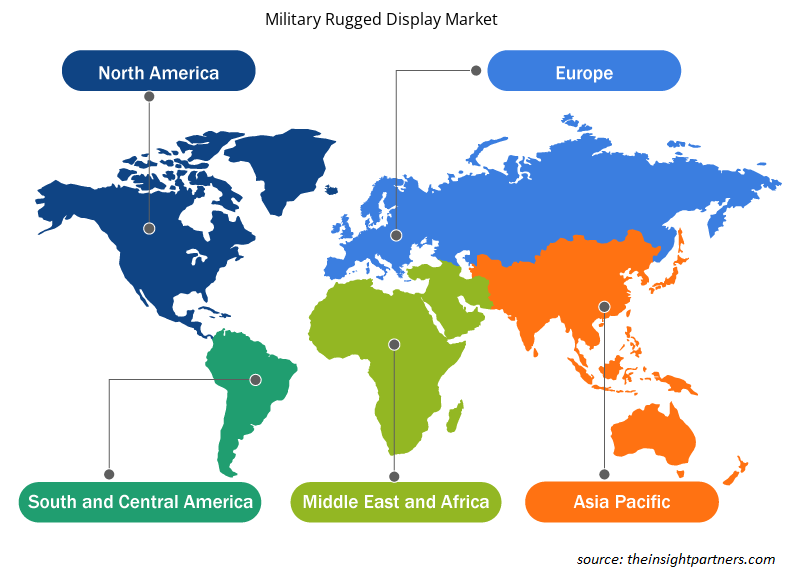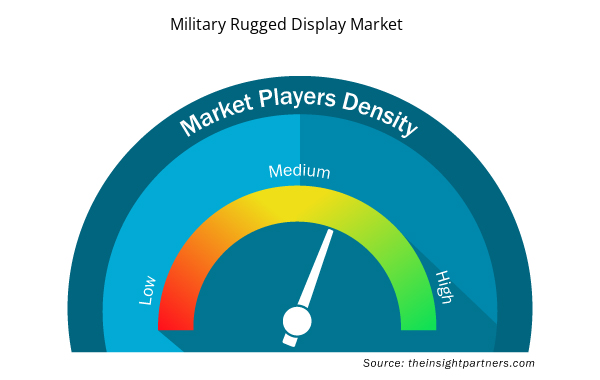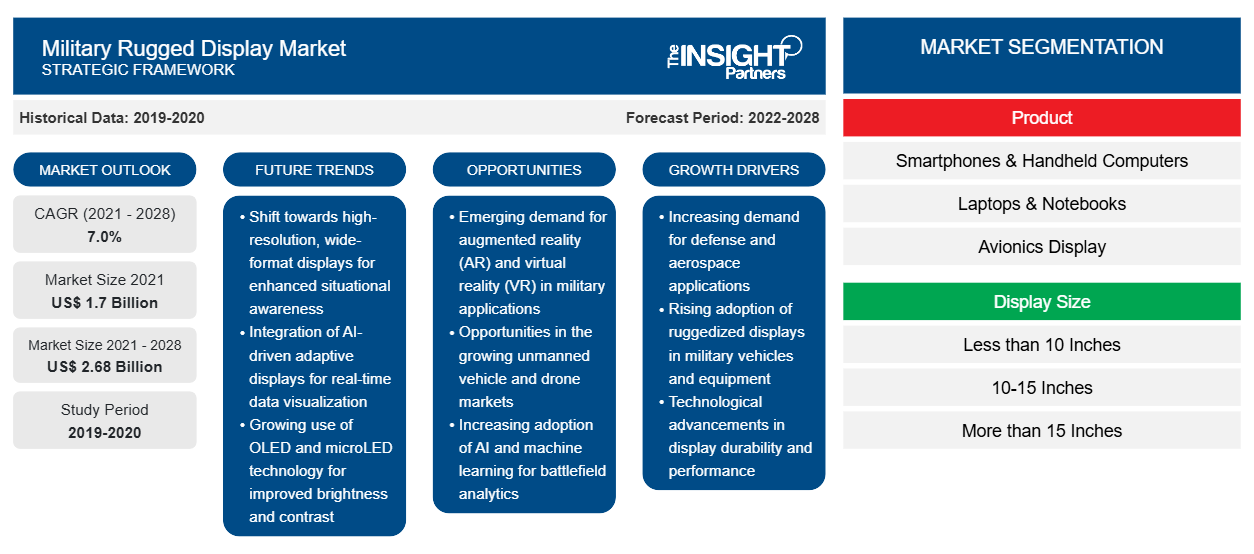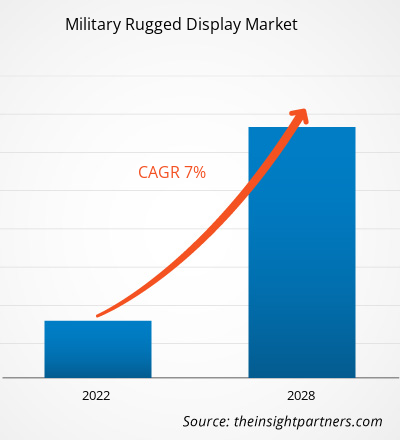Der Markt für robuste militärische Displays soll von 1.699,42 Millionen US-Dollar im Jahr 2021 auf 2.680,85 Millionen US-Dollar im Jahr 2028 wachsen; von 2021 bis 2028 wird mit einer durchschnittlichen jährlichen Wachstumsrate von 7,0 % gerechnet.
Die abgesessenen Soldaten und andere Streitkräfte nutzen verschiedene Arten robuster Geräte, die ihnen helfen, die nähere Umgebung zu verstehen und sich schnell zurechtzufinden. Die schnelle Reaktion der Benutzer wird durch die auf den Bildschirmen der robusten Geräte angezeigten Daten erreicht. Die Akteure auf dem Markt für robuste Displays für das Militär entwerfen und entwickeln zunehmend technologisch fortschrittliche robuste Displays, die verschiedenen Militäranwendern zugutekommen. So waren resistive Touchscreens im Laufe der Jahre bei den Streitkräften und Herstellern robuster Displays die Norm. In jüngster Zeit verlagern die Akteure auf dem Markt für robuste Displays für das Militär ihren Schwerpunkt jedoch von resistiven Touchscreens auf kapazitive Touchscreens, da kapazitive Touchscreens technologisch fortschrittlich und hochempfindlich auf Berührungen reagieren. Dank der hohen Empfindlichkeit können Benutzer problemlos und schnell durch Karten auf den Geräten navigieren, was ihnen hilft, sich in einen sichereren Bereich zu begeben. Die kapazitiven Bildschirme sind heller und die Daten sind bei Sonneneinstrahlung leicht lesbar, was die Lagebeurteilung auf dem Schlachtfeld verbessert. Daher übernehmen mehrere Streitkräfte auf der ganzen Welt solche Fortschritte, was das Wachstum des Marktes für robuste Displays für das Militär vorantreibt .
Passen Sie diesen Bericht Ihren Anforderungen an
Sie erhalten kostenlose Anpassungen an jedem Bericht, einschließlich Teilen dieses Berichts oder einer Analyse auf Länderebene, eines Excel-Datenpakets sowie tolle Angebote und Rabatte für Start-ups und Universitäten.
- Holen Sie sich die wichtigsten Markttrends aus diesem Bericht.Dieses KOSTENLOSE Beispiel umfasst eine Datenanalyse von Markttrends bis hin zu Schätzungen und Prognosen.
Der globale Markt für robuste militärische Displays wird nach Produkt, Displaygröße, Bildschirmtyp, Auflösung, Benutzern und Geografie kategorisiert. Das Produktsegment auf dem Markt für robuste militärische Displays wird anhand von Smartphones und Handheld-Computern, Laptops und Notebooks, Avionik-Displays, fahrzeugmontierten Displays sowie Panel-PCs und unternehmenskritischen Computern analysiert. Auf der Grundlage der Displaygröße wird der Markt für robuste militärische Displays in weniger als 10 Zoll, 10 – 15 Zoll und mehr als 15 Zoll segmentiert. Das Bildschirmtypsegment auf dem Markt für robuste militärische Displays wird anhand von Touchscreens und Nicht-Touchscreens analysiert. Das Auflösungssegment wird in High Definition (HD) und Full High Definition (FHD) unterteilt. Die Benutzer auf dem Markt für robuste militärische Displays sind Luftwaffe, Landstreitkräfte und Seestreitkräfte. Darüber hinaus wird die geografische Analyse anhand von Nordamerika, Europa, APAC, MEA und SAM durchgeführt.
Die aktuelle COVID-19-Pandemiekrise wirkt sich negativ auf die Welt aus und erschüttert weiterhin mehrere Länder. Bis zum Ausbruch verzeichnete die Rüstungsindustrie ein erhebliches Wachstum in Bezug auf Produktion und Dienstleistungen; die Krise stört jedoch die Lieferkette und die Herstellung von Rüstungsprodukten.
Die Rüstungsindustrie ist stark von Handarbeit abhängig und leidet aufgrund der Lockdown-Bestimmungen in vielen Ländern der Welt unter einem Mangel an Arbeitskräften in den jeweiligen Produktionsstätten. Darüber hinaus führte das Auftreten des COVID-19-Virus auf der ganzen Welt zu Lockdown-Szenarien und Branchenexperten zu der Analyse, dass die Branche mit einer Verzögerung von 4 bis 12 Wochen in der Lieferkette für militärische elektronische Teile rechnen muss. Diese Unterbrechung sorgte bis 2020 für Erschütterungen. Diese Faktoren schränkten die Produktion verschiedener Verteidigungsgeräte ein und behinderten damit das Wachstum des Marktes für robuste militärische Displays.
Regionale Einblicke in den Markt für robuste Militärdisplays
Die regionalen Trends und Faktoren, die den Markt für robuste Militärdisplays während des Prognosezeitraums beeinflussen, wurden von den Analysten von Insight Partners ausführlich erläutert. In diesem Abschnitt werden auch Marktsegmente und Geografien für robuste Militärdisplays in Nordamerika, Europa, im asiatisch-pazifischen Raum, im Nahen Osten und Afrika sowie in Süd- und Mittelamerika erörtert.

- Erhalten Sie regionale Daten zum Markt für robuste militärische Displays
Umfang des Marktberichts zu robusten Militärdisplays
| Berichtsattribut | Details |
|---|---|
| Marktgröße im Jahr 2021 | 1,7 Milliarden US-Dollar |
| Marktgröße bis 2028 | 2,68 Milliarden US-Dollar |
| Globale CAGR (2021 - 2028) | 7,0 % |
| Historische Daten | 2019-2020 |
| Prognosezeitraum | 2022–2028 |
| Abgedeckte Segmente | Nach Produkt
|
| Abgedeckte Regionen und Länder | Nordamerika
|
| Marktführer und wichtige Unternehmensprofile |
|
Dichte der Marktteilnehmer für robuste Displays für das Militär: Die Auswirkungen auf die Geschäftsdynamik verstehen
Der Markt für robuste Displays für militärische Zwecke wächst rasant. Dies wird durch die steigende Nachfrage der Endnutzer aufgrund von Faktoren wie sich entwickelnden Verbraucherpräferenzen, technologischen Fortschritten und einem größeren Bewusstsein für die Vorteile des Produkts vorangetrieben. Mit der steigenden Nachfrage erweitern Unternehmen ihr Angebot, entwickeln Innovationen, um die Bedürfnisse der Verbraucher zu erfüllen, und nutzen neue Trends, was das Marktwachstum weiter ankurbelt.
Die Marktteilnehmerdichte bezieht sich auf die Verteilung von Firmen oder Unternehmen, die in einem bestimmten Markt oder einer bestimmten Branche tätig sind. Sie gibt an, wie viele Wettbewerber (Marktteilnehmer) in einem bestimmten Marktraum im Verhältnis zu seiner Größe oder seinem gesamten Marktwert präsent sind.
Die wichtigsten Unternehmen auf dem Markt für robuste militärische Displays sind:
- Advanced Embedded Solutions GmbH
- Assured Systems GmbH
- Aydin Displays
- Kristallgruppe, Inc.
- General Digital Corporation
Haftungsausschluss : Die oben aufgeführten Unternehmen sind nicht in einer bestimmten Reihenfolge aufgeführt.

- Überblick über die wichtigsten Akteure auf dem Markt für robuste Militärdisplays
Zu den wichtigsten Unternehmen auf dem Markt für robuste militärische Displays zählen Advanced Embedded Solutions Ltd; Assured Systems; Aydin Displays; CP Technologies LLC; Crystal Group Inc.; General Digital Corporation; Hatteland Technology; Neuro Logic Systems, Inc.; Winmate Inc.; und ZMicro. Mehrere andere Unternehmen wurden ebenfalls analysiert, um ihren Beitrag zum Markt für robuste militärische Displays zu verstehen.
- Historische Analyse (2 Jahre), Basisjahr, Prognose (7 Jahre) mit CAGR
- PEST- und SWOT-Analyse
- Marktgröße Wert/Volumen – Global, Regional, Land
- Branche und Wettbewerbsumfeld
- Excel-Datensatz



Report Coverage
Revenue forecast, Company Analysis, Industry landscape, Growth factors, and Trends

Segment Covered
This text is related
to segments covered.

Regional Scope
North America, Europe, Asia Pacific, Middle East & Africa, South & Central America

Country Scope
This text is related
to country scope.
Häufig gestellte Fragen
Situational awareness or being aware of the location is paramount among the soldiers during the battle. The modern battlefield presents several challenges to situation awareness, which poses a substantial threat to the dismounted soldiers as well as vehicles (land, air, and naval). This is due to the fact that enemies or militant forces are using advanced technologies, which creates challenging situations for armed forces during decision making. Owing to enhance situational awareness among the on-battle soldiers, the demand for rugged devices is consistently growing, supporting the generating a generous amount of demand for the rugged display that functions smoothly under harshest environments. This factor is driving the military rugged display market.
Leonardo, Curtiss-Wright Corporation, Aydin Displays, ZMicro, and WNMATE are among the key market players operating in the global military rugged display market. The key players are listed upon considering factors such as overall revenue, current military rugged display product portfolio, geographical reach, market initiatives, investment in technology upgrades, partnerships, and other market-related activities.
North America is expected to hold the largest share of the military rugged display market during the forecast period. The growth of the market in this region is majorly driven by factors such as the growing implementation of advanced military rugged display and extensive government investments in the US defense sector. In addition, the presence of major market players such as Aydin Displays, Curtiss-Wright Corp, and General Micro Systems Inc., and reduction in the total cost of ownership (TCO) are among other factors supporting the market growth in the region.
Military rugged displays provide crystal clear picture quality in extreme environmental conditions. These displays enhance direct sunlight readability and work in extremely low light applications; moreover, they are compatible with flexible night vision operations. Based on the product, the market is segmented into a smartphone and handheld computer, laptop and notebook, avionics display, vehicle-mounted computer, panel PC and mission-critical display. The military rugged displays have escalated the demand for smartphones and handheld computers that are lightweight, thinner, and cheaper; they also feature high reliability and durability.
The defense aircraft manufacturers worldwide are focusing heavily on manufacturing and marketing advanced aircraft to the military forces. In order to support the demand for smooth aircraft operations under harsh environments, the military forces are urging the aircraft OEMs to increase the internal and external ruggedness of the aircraft models. With an objective to meet the requirements, the airframers are seeking advanced solutions such as lightweight, durable, and rugged materials for exterior and interior applications, including avionics displays. This factor is catalyzing the adoption of rugged displays for military avionics, which is propelling the military rugged display market.
The growing demand for ruggedized displays with fast response time, high resolution, and optimal picture quality is anticipated to propel military rugged display manufacturers toward significant innovations. The rising adoption of high-definition displays in smartphones, laptops, PCs, and other electronic gadgets is one of the substantial factors expected to drive the growth of the market. Features such as high picture resolution and extensive color range also escalate the demand for high-definition displays.
Trends and growth analysis reports related to Electronics and Semiconductor : READ MORE..
The List of Companies - Military Rugged Display Market
- Advanced Embedded Solutions Ltd
- Assured Systems Ltd
- Aydin Displays
- Crystal Group, Inc.
- General Digital Corporation
- Hatteland Technology AS
- Neuro Logic Systems, Inc.
- Winmate Inc.
- ZMicro, Inc.
- CP Technologies LLC
The Insight Partners performs research in 4 major stages: Data Collection & Secondary Research, Primary Research, Data Analysis and Data Triangulation & Final Review.
- Data Collection and Secondary Research:
As a market research and consulting firm operating from a decade, we have published and advised several client across the globe. First step for any study will start with an assessment of currently available data and insights from existing reports. Further, historical and current market information is collected from Investor Presentations, Annual Reports, SEC Filings, etc., and other information related to company’s performance and market positioning are gathered from Paid Databases (Factiva, Hoovers, and Reuters) and various other publications available in public domain.
Several associations trade associates, technical forums, institutes, societies and organization are accessed to gain technical as well as market related insights through their publications such as research papers, blogs and press releases related to the studies are referred to get cues about the market. Further, white papers, journals, magazines, and other news articles published in last 3 years are scrutinized and analyzed to understand the current market trends.
- Primary Research:
The primarily interview analysis comprise of data obtained from industry participants interview and answers to survey questions gathered by in-house primary team.
For primary research, interviews are conducted with industry experts/CEOs/Marketing Managers/VPs/Subject Matter Experts from both demand and supply side to get a 360-degree view of the market. The primary team conducts several interviews based on the complexity of the markets to understand the various market trends and dynamics which makes research more credible and precise.
A typical research interview fulfils the following functions:
- Provides first-hand information on the market size, market trends, growth trends, competitive landscape, and outlook
- Validates and strengthens in-house secondary research findings
- Develops the analysis team’s expertise and market understanding
Primary research involves email interactions and telephone interviews for each market, category, segment, and sub-segment across geographies. The participants who typically take part in such a process include, but are not limited to:
- Industry participants: VPs, business development managers, market intelligence managers and national sales managers
- Outside experts: Valuation experts, research analysts and key opinion leaders specializing in the electronics and semiconductor industry.
Below is the breakup of our primary respondents by company, designation, and region:

Once we receive the confirmation from primary research sources or primary respondents, we finalize the base year market estimation and forecast the data as per the macroeconomic and microeconomic factors assessed during data collection.
- Data Analysis:
Once data is validated through both secondary as well as primary respondents, we finalize the market estimations by hypothesis formulation and factor analysis at regional and country level.
- Macro-Economic Factor Analysis:
We analyse macroeconomic indicators such the gross domestic product (GDP), increase in the demand for goods and services across industries, technological advancement, regional economic growth, governmental policies, the influence of COVID-19, PEST analysis, and other aspects. This analysis aids in setting benchmarks for various nations/regions and approximating market splits. Additionally, the general trend of the aforementioned components aid in determining the market's development possibilities.
- Country Level Data:
Various factors that are especially aligned to the country are taken into account to determine the market size for a certain area and country, including the presence of vendors, such as headquarters and offices, the country's GDP, demand patterns, and industry growth. To comprehend the market dynamics for the nation, a number of growth variables, inhibitors, application areas, and current market trends are researched. The aforementioned elements aid in determining the country's overall market's growth potential.
- Company Profile:
The “Table of Contents” is formulated by listing and analyzing more than 25 - 30 companies operating in the market ecosystem across geographies. However, we profile only 10 companies as a standard practice in our syndicate reports. These 10 companies comprise leading, emerging, and regional players. Nonetheless, our analysis is not restricted to the 10 listed companies, we also analyze other companies present in the market to develop a holistic view and understand the prevailing trends. The “Company Profiles” section in the report covers key facts, business description, products & services, financial information, SWOT analysis, and key developments. The financial information presented is extracted from the annual reports and official documents of the publicly listed companies. Upon collecting the information for the sections of respective companies, we verify them via various primary sources and then compile the data in respective company profiles. The company level information helps us in deriving the base number as well as in forecasting the market size.
- Developing Base Number:
Aggregation of sales statistics (2020-2022) and macro-economic factor, and other secondary and primary research insights are utilized to arrive at base number and related market shares for 2022. The data gaps are identified in this step and relevant market data is analyzed, collected from paid primary interviews or databases. On finalizing the base year market size, forecasts are developed on the basis of macro-economic, industry and market growth factors and company level analysis.
- Data Triangulation and Final Review:
The market findings and base year market size calculations are validated from supply as well as demand side. Demand side validations are based on macro-economic factor analysis and benchmarks for respective regions and countries. In case of supply side validations, revenues of major companies are estimated (in case not available) based on industry benchmark, approximate number of employees, product portfolio, and primary interviews revenues are gathered. Further revenue from target product/service segment is assessed to avoid overshooting of market statistics. In case of heavy deviations between supply and demand side values, all thes steps are repeated to achieve synchronization.
We follow an iterative model, wherein we share our research findings with Subject Matter Experts (SME’s) and Key Opinion Leaders (KOLs) until consensus view of the market is not formulated – this model negates any drastic deviation in the opinions of experts. Only validated and universally acceptable research findings are quoted in our reports.
We have important check points that we use to validate our research findings – which we call – data triangulation, where we validate the information, we generate from secondary sources with primary interviews and then we re-validate with our internal data bases and Subject matter experts. This comprehensive model enables us to deliver high quality, reliable data in shortest possible time.


 Holen Sie sich ein kostenloses Muster für diesen Bericht
Holen Sie sich ein kostenloses Muster für diesen Bericht